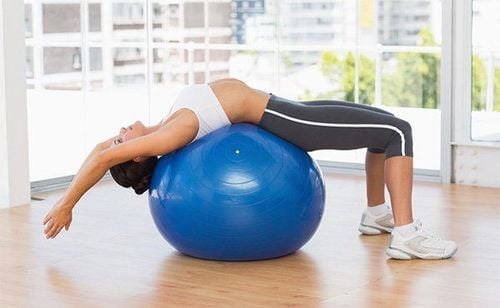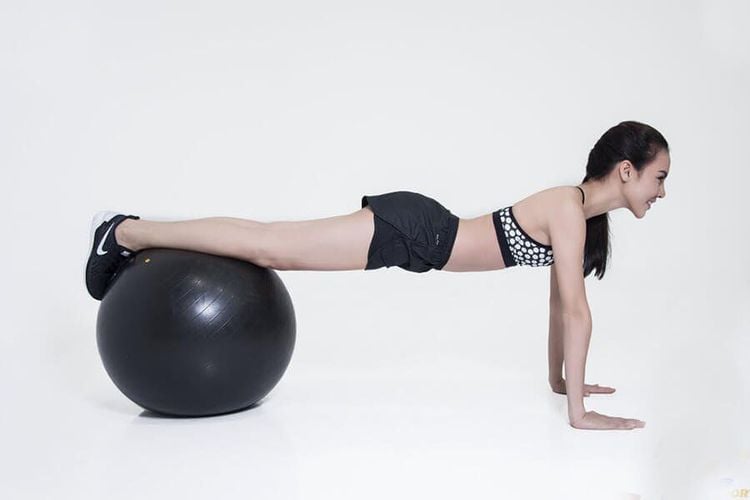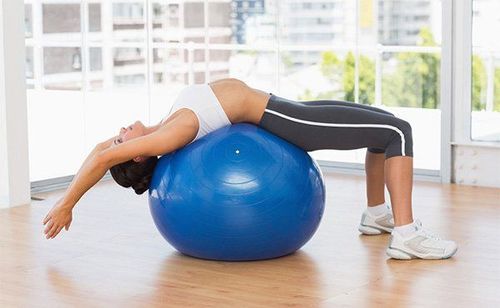This is an automatically translated article.
Exercise balls are one of the best tools for increasing core strength, endurance, and stability. By adding a ball to some moves, you add even more intensity, making a core workout challenging. Just make sure you're comfortable using the exercise ball and take the time to practice. Learn more about core strength exercises with the gym ball in the article below.1. How to use exercise ball in practice?
Exercise balls are one of the best training tools for improving strength, endurance, and stability in core muscle groups. Because our bodies are placed on an unstable surface, the muscles, especially the core muscles, have to work harder to keep your balance. By adding a gym ball to some moves, we can even increase the intensity, making using the gym ball in our workouts a challenging core workout.Plus with the exercise ball, we not only strengthen your core, but also improve your balance and coordination. Just make sure you are comfortable using the exercise ball as some movements can be difficult. Therefore, take the time to familiarize yourself with the practice ball and learn how to balance it before applying it to specific exercises.
All that is needed for a ball exercise is an exercise ball, a mat and a light medium ball (recommended weight: 1.5 – 3 kg). However, it is important to talk to your doctor before trying this exercise if you have any injuries, medical conditions or other health problems.
How to work out with the gym ball
Warm up for 5 to 10 minutes with the usual cardio or strength exercises we usually do. Perform each exercise as described below about 1 to 3 sets of 12 to 16 reps. Adjust movements to suit your fitness level and skip any exercises that cause pain or discomfort. Take at least one day of rest between each workout.

Luyện tập với bóng thể dục là một trong những cách tốt nhất để nâng cao sức khoẻ

Plank chân với bóng thể dục nâng cao sức mạnh cốt lõi của chân
2. 5 ball exercises with gymnastics that strengthen core muscle groups
2.1. Sit-ups with gym ball
Performing a controlled crunch on the surface of an exercise ball will strengthen the abdominal area more than a regular crunch.How to do it: Sit on an exercise ball and bring your legs forward so that your shoulders, neck, and thighs are parallel to the floor. Put your neck in the most relaxed state, bring your hands behind your head. Focus on your center of gravity and lift your shoulder blades off the ball, pausing when your body reaches a 45-degree angle. Keep your gaze up to the sky or to the ceiling so you don't put too much pressure on your neck. Pause, then gently lower your upper body back down to the starting position. This movement has nothing to do with speed, so the slower we go, the more effective the exercise will be. Repeat the above movements 10 times.
2.2. Hand extension exercise
Lower your shoulders and center of gravity. Extension exercises performed on an exercise ball will increase the range of motion of the hands more than when we do these movements on the floor.How to do it: Place chest on an exercise ball, legs extended straight back. Try to balance with your toes. Place your body in a plank position and your head in a neutral position. Keeping your center of gravity, glutes, and back focused, drop your arms off your shoulders but don't touch the ground or the ball. Then, raise your arms and stretch them straight over your head so that your body makes the letter "Y.". Lower your arms. Next, raise the arms so that they extend straight out from the sides to form a "T" shape. Lower your arms. Repeat each step over 10 times.
2.3. Ball Roll-Outs Stabilization Exercise
Experts say that using an exercise ball to roll your body can help toned muscles much more than traditional forms of exercise. However, this is also one of the more difficult exercises, with all muscle groups, especially the hamstrings.How to do it: Start by kneeling on the ground, trying to balance with your toes, not your entire foot. Place an exercise ball in front of you. Place your forearm on top of the ball so that your arm forms a 90-degree angle. Push yourself off your toes and roll forward to balance on the ball in a plank position. Our body should form a straight line from head to heel. Hold for a second, then bend your knees and slowly roll back to the starting position. Repeat the above steps 10 times.

Bài tập căng cơ bụng với bóng thể dục nhắm đến các nhóm cơ cốt lõi
2.4. Abdominal stretching exercises
For this exercise, the lower back of the practitioner will be balanced on an exercise ball, to do that, the practitioner will need stable core muscle groups to perform this move. This is a two-in-one exercise because it targets both your glutes and core muscle groups.How to do it: Sit on an exercise ball with your feet flat on the floor. Step your feet forward and roll your back onto the ball so that your shoulders and upper back are supported by the ball. Contract and lift your butt off the floor. The practitioner's shoulders and back should remain on the ball and hold for two seconds. Drop your hips to the floor, then squeeze and lift your butt up again. Repeat these movements 10 times.
2.5. Squat exercise with gym ball
The squat exercise with an exercise ball helps the practitioner exercise their glutes, hip muscles and core muscle groups. In addition, this exercise also supports a lot of our lower back.How to do it: Stand with an exercise ball about halfway between the wall and your lower back. You should face away from the wall, standing tall with your shoulder blades pulled back. Lean on the ball and make sure your weight is completely on your heels. With your hands on your hips, slowly lower yourself into a squat until your knees are bent at 90 degrees and your thighs are parallel to the ground. Next, squeeze your glutes and work your glutes, hamstrings, and core muscle groups to get up. Repeat this movement 10 times.
Core exercises are exercises that strengthen your core muscle groups, including strengthening your abs, back muscles, and muscles around your pelvis. You can do many core strength exercises with an exercise ball. In general, use an exercise ball that is sized so that your knees are at a right angle as you sit on the ball with your feet flat on the floor. Do each core strength exercise five times and maintain a good technique. Once you get used to the ball, increase the intensity to 12 to 15 reps. For most people, an exercise of 12 to 15 repetitions can best build strength and improve fitness. Breathe freely, deeply, and focus on tightening your abs during each core strength exercise. If you have back pain, osteoporosis or any other health problem, talk to your doctor before doing these core strength exercises.
Please follow the website ( www.vinmec.com ) for more information on health care instructions, which we will update regularly.
Please dial HOTLINE for more information or register for an appointment HERE. Download MyVinmec app to make appointments faster and to manage your bookings easily.
References: mayoclinic.org, verywellfit.com, dailyburn.com









